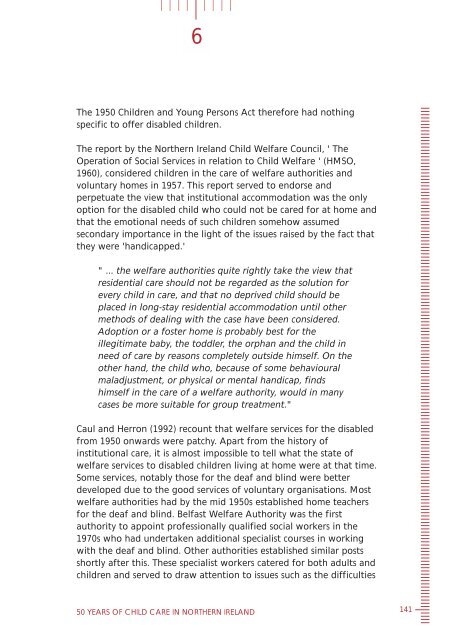childcare-50years
childcare-50years
childcare-50years
Create successful ePaper yourself
Turn your PDF publications into a flip-book with our unique Google optimized e-Paper software.
6<br />
The 1950 Children and Young Persons Act therefore had nothing<br />
specific to offer disabled children.<br />
The report by the Northern Ireland Child Welfare Council, ' The<br />
Operation of Social Services in relation to Child Welfare ' (HMSO,<br />
1960), considered children in the care of welfare authorities and<br />
voluntary homes in 1957. This report served to endorse and<br />
perpetuate the view that institutional accommodation was the only<br />
option for the disabled child who could not be cared for at home and<br />
that the emotional needs of such children somehow assumed<br />
secondary importance in the light of the issues raised by the fact that<br />
they were 'handicapped.'<br />
" ... the welfare authorities quite rightly take the view that<br />
residential care should not be regarded as the solution for<br />
every child in care, and that no deprived child should be<br />
placed in long-stay residential accommodation until other<br />
methods of dealing with the case have been considered.<br />
Adoption or a foster home is probably best for the<br />
illegitimate baby, the toddler, the orphan and the child in<br />
need of care by reasons completely outside himself. On the<br />
other hand, the child who, because of some behavioural<br />
maladjustment, or physical or mental handicap, finds<br />
himself in the care of a welfare authority, would in many<br />
cases be more suitable for group treatment."<br />
Caul and Herron (1992) recount that welfare services for the disabled<br />
from 1950 onwards were patchy. Apart from the history of<br />
institutional care, it is almost impossible to tell what the state of<br />
welfare services to disabled children living at home were at that time.<br />
Some services, notably those for the deaf and blind were better<br />
developed due to the good services of voluntary organisations. Most<br />
welfare authorities had by the mid 1950s established home teachers<br />
for the deaf and blind. Belfast Welfare Authority was the first<br />
authority to appoint professionally qualified social workers in the<br />
1970s who had undertaken additional specialist courses in working<br />
with the deaf and blind. Other authorities established similar posts<br />
shortly after this. These specialist workers catered for both adults and<br />
children and served to draw attention to issues such as the difficulties<br />
50 YEARS OF CHILD CARE IN NORTHERN IRELAND<br />
141


